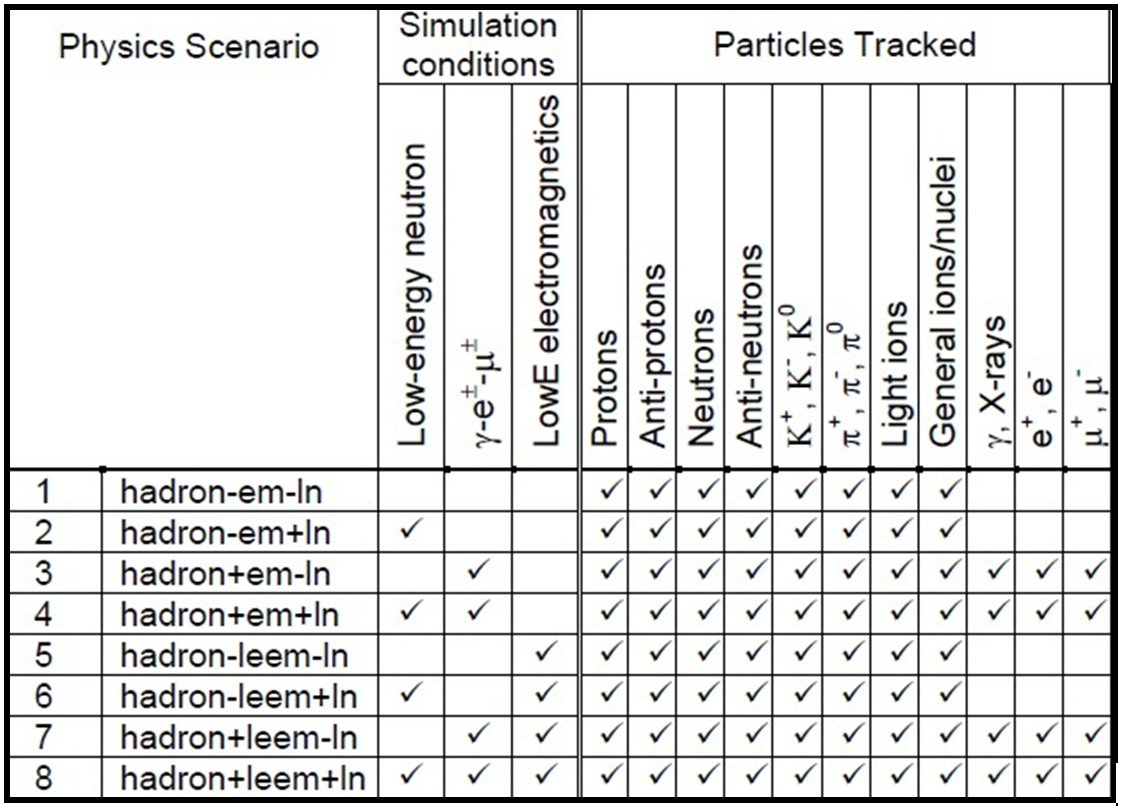| GEMAT | MULASSIS |
| Fluence of particle entering each SV and record their energy spectrum | Fluence spectra at the boundaries between the different layers |
| Pulse-height spectrum of energy deposition in each SV | Non-ionizing energy loss (NIEL) analysis at the boundaries of layers |
| Path length distribution in units of events .bin-1 per incident particle | Energy deposition/Total ionizing dose in any layer |
| Coincidence rates between the SVs | Pulse-height spectrum (PHS) of energy deposition at any layer |
Geant4 is a Monte Carlo radiation transport toolkit used to simulate the complex electromagnetic and nuclear interactions of high-energy particles in virtually any material. As part of the Monte Carlo simulation, all secondary particles are tracked to the range cut-off limits defined for the geometry. However, note that MULASSIS functions in a very different approach when simulating SEP protons and heavier ions:
- For protons, MULASSIS operates in normal Monte Carlo (MC) simulation mode, tracking particle histories and all secondaries produced by interaction.
- For α particles and heavier ions, MULASSIS uses a non-MC simulation (so-called "IRONSSIS" mode) to use Geant4's ion range-versus-energy and stopping-power-versus-energy tables to derive the same quantities as the traditional MULASSIS MC calculation, but using the continuous slowing-down approximation (CSDA) straight ahead approach. This greatly speeds up the calculation whilst retaining good accuracy of the results for residual ion fluxes after shielding, and ionising and non-ionising dose estimates. This provides significant advantages if response functions need to be generated for a wide range of ions (potentially from Z=2 to 92) at 11 energy channels. However, the disadvantage is there is no treatment of secondary particles, particularly neutrons from energetic ion-nuclear interactions.
MULASSIS and GEMAT in SEPEM
In SEPEM both tools can be applied by users with no programming
experience and very little knowledge of Geant4 itself. SEPEM users only
have to define the data table, the particle species, the device geometry
and the device material(s). Appopriate physics lists are selected by the
SEPEM software from the table below, depending on the type of simulation.

|
References
[1] Geant4: http://geant4.web.cern.ch/geant4.
[2] GEMAT: URD and
SSD
[3] MULASSIS/IRONSSIS
The Space Environment and Effects Section at ESA/ESTEC is maintaining a repository of Geant4-related codes developed by ESA-funded projects.
Last modified: 24 October 2017






